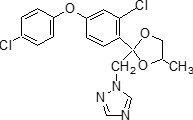Fungicide
Difenoconazole
TC & FORMULATION: 95%TC, 250G/L EC, 10%WDG, 30G/L FS
Structure Formula
NOMENCLATURE 
Common name difenoconazole (BSI, draft E-ISO)
IUPAC name cis,trans-3-chloro-4-[4-methyl-2-(1H-1,2,4-triazol-1-ylmethyl)-1,3-dioxolan-2-yl]phenyl 4-chlorophenyl ether
Chemical Abstracts name 1-[2-[2-chloro-4-(4-chlorophenoxy)phenyl]-4-methyl-1,3-dioxolan-2-ylmethyl]-1H-1,2,4-triazole
CAS RN [119446-68-3] unstated stereochemistry
PHYSICAL CHEMISTRY
Composition Ratio of cis- to trans- isomers is in the range 0.7 to 1.5. Mol. wt. 406.3 M.f. C19H17Cl2N3O3 Form White to light beige crystals. M.p. 82.0-83.0 °C V.p. 3.3 ´ 10-5 mPa (25 ºC) KOW logP = 4.4 (25 ºC) Henry 1.5 ´ 10-6 Pa m3 mol-1 (calc.) S.g./density 1.40 (20 ºC) Solubility In water 15 mg/l (25 ºC). In ethanol 330, acetone 610, toluene 490, n-hexane 3.4, n-octanol 95 (all in g/l, 25 ºC). Stability Stable up to 150 ºC. Hydrolytically stable. pKa 1.1
APPLICATIONS
Biochemistry Sterol demethylation inhibitor. Inhibits cell membrane ergosterol biosynthesis, stopping development of the fungus. Mode of action Systemic fungicide with preventive and curative action. Absorbed by the leaves, with acropetal and strong translaminar translocation. Uses Systemic fungicide with a novel broad-range activity protecting the yield and crop quality by foliar application or seed treatment. Provides long-lasting preventive and curative activity against Ascomycetes, Basidiomycetes and Deuteromycetes including Alternaria, Ascochyta, Cercospora, Cercosporidium, Colletotrichum, Guignardia, Mycosphaerella, Phoma, Ramularia, Rhizoctonia, Septoria, Uncinula, Venturia spp., Erysiphaceae, Uredinales and several seed-borne pathogens. Used against disease complexes in grapes, pome fruit, stone fruit, potatoes, sugar beet, oilseed rape, banana, cereals, rice, soya beans, ornamentals and various vegetable crops, at 30-125 g/ha. Used as a seed treatment against a range of pathogens in wheat and barley, at 3-24 g/100 kg seed. Phytotoxicity In wheat, early foliar applications at growth stages 29-42 might cause, in certain circumstances, chlorotic spotting of leaves, but this has no effect on yield. Formulation types DS; EC; FS; SC; WG.
About price and product information, please click Message button.
Open the consulting page, please Writing information, customer manager will reply within 24 hours!
or Contact email:Donna.wen@molotuschem.com
Cell-phone number:17717500809
Tel:0086 21 61203246
Fax:0086 21 61612025
Address:Room 402, No.553, Maotai Road, Changning District, Shanghai.







